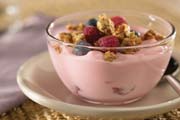
Think of a breakfast yogurt loaded with good-for-you ingredients that primes the body to take on the day. What about a cultured smoothie to take you from lunch to dinner and helps support the health of your gut? And for nighttime, a fermented milk with ingredients that may relax the mind and at the same time help recharge your insides so you can manage another day of life's stresses?
Such cultured dairy products are already available in Europe and Asia, where consumers are quite in tune with intestinal health and dietary means for
enhancing well being. This trend is catching on in the United States, providing an opportunity for dairy processors to explore an area where few in the
United States, to date, have dared to go.

The power of probiotics
probiotics. The term probiotics means "for life." It was defined by a group of experts convened by the Food and Agriculture Organization (FAO) of the United Nations as "microorganisms administered in adequate amounts which confer a beneficial health effect on the host."There is some debate about whether yogurt starter cultures-Lactobacillus bulgaricus and Streptococcus thermophilus-should be considered probiotic, as these cultures are not very resistant to the bile released into the small intestine, and thus are not maintained alive in the gastrointestinal tract in very high numbers. However, these cultures have been proven to improve lactose digestion in people lacking the enzyme lactase. They have also demonstrated some immune-enhancing properties. Thus, many experts consider these yogurt starters to be probiotics. Furthermore, today, many U.S. yogurts contain Lactobacillus acidophilus and/or Bifidobacterium bifidum, both of which are lactic acid bacteria that are universally recognized as probiotics.
The link between dairy and probiotics can be traced back more than 2,000 years to a time when people consumed large amounts of lactic acid-fermented milk products such as kefir and yogurt. More recently, researchers correlated consumption of lactic acid bacteria-fermented dairy foods with longevity and health.
"Probiotic bacteria have a long history with dairy products," says Mary Ellen Sanders, a consultant with Centennial, Colo.-based Dairy and Food Culture Technologies and president of the International Scientific Association of Probiotics and Prebiotics (ISAPP), an association of academic and industrial scientists involved in research on fundamental and applied aspects of probiotics and prebiotics. The scientists participating in ISAPP have a common interest in generating high-quality scientific information for the probiotic and prebiotic fields and providing guidance for collaborative and multidisciplinary research.
"Some of the same bacteria that are associated with fermented dairy products also make their homes in different sites on the human body," says Sanders. "Thus, some cultures are not only able to transform milk into a diverse array of fermented dairy products, they also can provide benefits to human health.
"Today, in the United States, foods containing beneficial probiotic bacteria are almost exclusively dairy products," Sanders continues. "If the dairy
industry wants to continue to own probiotics, investigating all angles of the long-standing relationship between dairy foods and probiotics must be conducted."

Proving the beneficial effects
Probiotics, along with a very large and diverse range of other bacteria, colonize the human body. These bacteria play a significant role in human physiology. For example, probiotics have been shown to lower the pH of the intestinal tract so that pathogenic bacteria cannot survive. In addition, growing beneficial bacteria compete with pathogens for nutrients and space in the intestinal tract. Probiotics also are associated with preventing diarrhea, relieving constipation, building immunity, preventing skin allergy and improving women's urogenital health.In addition to the two most common probiotics-L. acidophilus and B. bifidum-other lactic acid-producing bacteria have been clinically studied and shown to positively affect health.
"The future of probiotics holds much promise," says Sanders. "However, the data supporting their use is still emerging and has limitations. But this should not stop dairy processors from moving forward. There are reliable probiotic suppliers in the industry.
"Ask the supplier for documented clinical research on a specific strain," says Sanders. "Ask for studies showing the strains' survival rate through a dairy product's shelflife."
Clinical trials are applicable only for the specific strain tested. Once a strain has been shown to exert beneficial effects on the human body, it must be delivered to the body at an effective dosage. The probiotics must be able to survive in the carrier food (i.e., yogurt) until the time of consumption in levels that ensure sufficient viable organisms are transported to the site in the body where they do the most good, which, depending on the probiotic might be the mouth, stomach, intestine or vaginal tract.
Genomics are also playing a key role in probiotic research. "The genomes of five probiotic Lactobacillus and Bifidobacterium strains are already sequenced, and genome sequences of 12 additional probiotic strains are on the way," says Todd Klaenhammer, director of the Southeast Dairy Foods Research Center in Raleigh, N.C. "With such extensive genomic data, we are now able to recognize genes critical for survival, colonization and activity in the human tissues. Once identified, ‘chip' or microarray technology can be used to determine how delivery in milk or fermented dairy products affects expression of these desirable genes. We already know that when some probiotics are delivered in fermented (acidified) dairy products, the bacteria are preconditioned for acid tolerance and as such are more likely to survive passage through the human stomach."
"Dairy foods may well turn out to be the ideal vehicle for reintroducing probiotics to the human gastrointestinal system," he adds.
Dairy foods and probiotics: A perfect opportunity.
Sidebar: Communicating Probiotic Benefits to U.S. Consumers
"Every company manufacturing probiotic culture-containing dairy foods should be educating consumers about the benefits of consuming probiotics," says Mary Jo Viederman, founder of Living Out Loud Communications, Amherst, Mass., and former v.p. of communications with Stonyfield Farm, Londonderry, N.H.Viederman, a speaker at DMI's 2004 Dairy Innovations Forum, urges marketers of probiotic-containing dairy foods to do three things. "First, create a packet of materials that describes, in consumer-friendly language, the tangible benefits identified from clinical studies," she says. "Second, engage a professional to endorse the product. Third-person testimonials go a long way. The professional can be a celebrity or sports star. Registered dieticians and pediatricians are great, too."
The third step is a little more challenging because it is constant work. But, according to Viederman, it pays off. (It did for Stonyfield, a company that became the third-largest U.S. yogurt manufacturer within 20 years of being founded.)
"You must implement an educational outreach program," she says. "Sampling is a very powerful program. But it's not just sampling in a store. It's at family events and neighborhood festivals. Every time there's an opportunity for face-to-face contact with potential customers, jump on it. Have reliable people working for you who can communicate why your product line offers something beyond and better than others in the marketplace."

Sidebar: Perfect Timing: Dairy's Role in Weight Management Complements Consumers' Pursuit of Health and Wellness
Today's consumers demand foods and beverages that assist with improving health and well-being. In fact, the largest population group in the history of the country is in its 40s and 50s, and has no intention of growing old without a good fight. Furthermore, with two thirds of American adults overweight or obese, many consumers are changing their lifestyles to include better-for-you foods that will help keep them fit and age slowly. Dairy foods can do this, and a whole lot more.Dairy's nutritional story goes beyond the well-known benefits of calcium, protein, potassium and other nutrients, or the advantages of consuming live and active probiotic cultures. What has recently been discovered is that dairy may aid in weight loss.
A recent study published in Obesity Research showed that people on a reduced-calorie diet who consumed three servings of milk, cheese or yogurt each day lost significantly more weight and more body fat than those who just cut calories while consuming little or no dairy. The mix of nutrients found in dairy foods, especially calcium, may be responsible for helping the body break down and burn fat.
In addition, emerging research suggests that higher daily intake of proteins and their components, especially the higher amounts of leucine found in dairy proteins, may help people lose fat while preserving lean muscle mass.
For more information on dairy and weight loss, visit www.healthyweightwithdairy.com.


